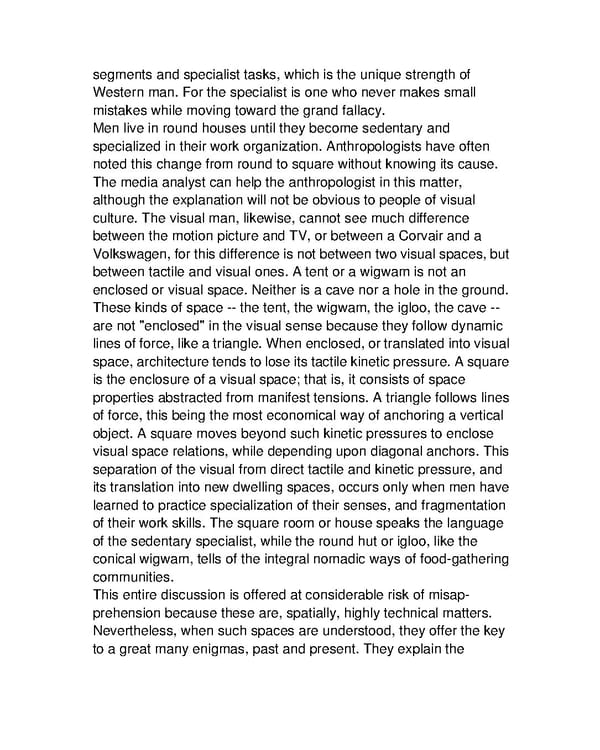segments and specialist tasks, which is the unique strength of Western man. For the specialist is one who never makes small mistakes while moving toward the grand fallacy. Men live in round houses until they become sedentary and specialized in their work organization. Anthropologists have often noted this change from round to square without knowing its cause. The media analyst can help the anthropologist in this matter, although the explanation will not be obvious to people of visual culture. The visual man, likewise, cannot see much difference between the motion picture and TV, or between a Corvair and a Volkswagen, for this difference is not between two visual spaces, but between tactile and visual ones. A tent or a wigwam is not an enclosed or visual space. Neither is a cave nor a hole in the ground. These kinds of space -- the tent, the wigwam, the igloo, the cave -- are not "enclosed" in the visual sense because they follow dynamic lines of force, like a triangle. When enclosed, or translated into visual space, architecture tends to lose its tactile kinetic pressure. A square is the enclosure of a visual space; that is, it consists of space properties abstracted from manifest tensions. A triangle follows lines of force, this being the most economical way of anchoring a vertical object. A square moves beyond such kinetic pressures to enclose visual space relations, while depending upon diagonal anchors. This separation of the visual from direct tactile and kinetic pressure, and its translation into new dwelling spaces, occurs only when men have learned to practice specialization of their senses, and fragmentation of their work skills. The square room or house speaks the language of the sedentary specialist, while the round hut or igloo, like the conical wigwam, tells of the integral nomadic ways of food-gathering communities. This entire discussion is offered at considerable risk of misap- prehension because these are, spatially, highly technical matters. Nevertheless, when such spaces are understood, they offer the key to a great many enigmas, past and present. They explain the
 Understanding Media by Marshall McLuhan Page 139 Page 141
Understanding Media by Marshall McLuhan Page 139 Page 141